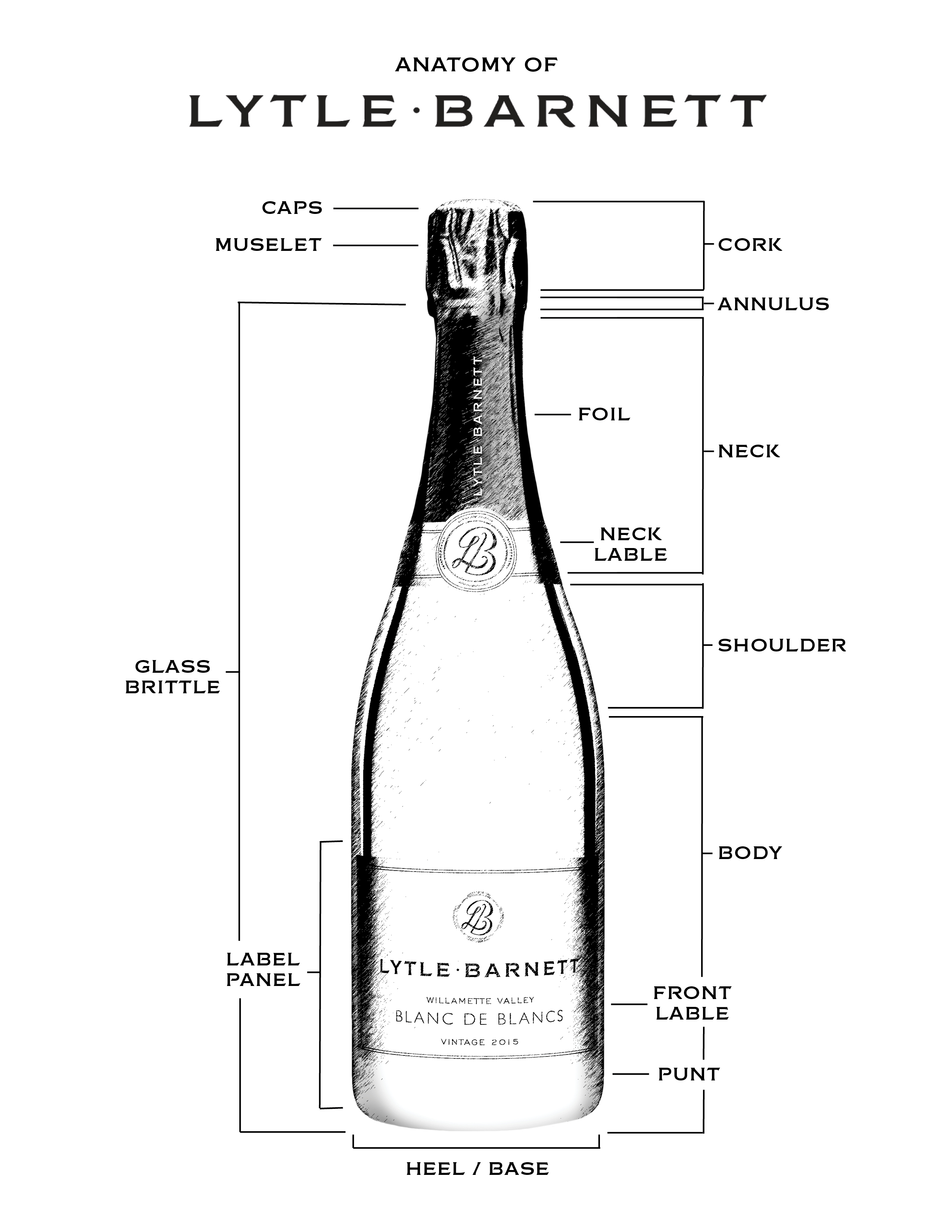What’s Punt 酒底既凹位
引用文章:
https://lytle-barnett.com/blog/PRODUCTION/The-Anatomy-of-Lytle-Barnett-Sparkling-Wine-Bottles
Our sparkling wine is made in the French tradition, and we use bottles that mirror those used for Champagne. Today we will be breaking down the specific architecture of these bottles, starting from the top!
CAPS – A metal cap is incorporated in our design and sits on the muselet which shows the Lytle-Barnett emblem and the purpose is to help hold the cork in place.
MUSELET – The wire cage that secures the cork in the bottle, keeping it sealed to the point of drinking. “Mesulet” which comes from the French word museler (muzzle).
CORK – Champagne corks are produced from natural cork and are critical in sealing the product. The cork is held in place by a wire cage (Muselet) topped with a metal cap (Cap).
ANNULUS – The annulus is the rim at the top of the neck. This is important to the closure mechanism as it is the anchor point for the wire cage that holds the cork in the bottle.
FOIL – The foil covers the neck of the bottle and also covers the cork arrangement. Its purpose is purely to keep the cork clean.
NECK – The slender part of the bottle between the closure and the shoulder.
SHOULDER – The shoulder of the Champagne bottle is fairly self-explanatory and separates the neck and body. They come in various profiles depending on the bottle design.
BODY – The body is the main part of the bottle, generally cylindrical but diameter can vary from top to bottom (larger at the top than the bottom, or vice versa).
LABEL PANEL – The label panel is where you should find information about the wine. Some of the information is controlled by law like volume of the liquid, ABV (alcohol content by volume), standard drinks, vintage, varietal, origin etc. Each producing country has different regulations.
FRONT LABEL – Where to find key information on the front of the bottle. Opposite the front label may be a back-label where the producer is free to add more information.
PUNT – At the very bottom of the bottle you will find an indentation in the glass. This is correctly named the Punt. It is there to give the bottle greater strength in order to be able to cope with the pressure created by the dissolved CO2 in the Champagne which provides the all important fizz. Incidentally, there is around 2-3 times the pressure of a car tire inside a bottle of Champagne (5-6 bar typically).
** NOTE Famously bottles of Roederer Cristal Champagne don’t have one because Tsar Alexander II of Russia who ordered the wine was afraid it may hide something lethal.
HEEL/BASE – The heel is simply the base of the bottle.
Calendar
| S | M | T | W | T | F | S |
|---|---|---|---|---|---|---|
| 1 | 2 | 3 | 4 | 5 | 6 | |
| 7 | 8 | 9 | 10 | 11 | 12 | 13 |
| 14 | 15 | 16 | 17 | 18 | 19 | 20 |
| 21 | 22 | 23 | 24 | 25 | 26 | 27 |
| 28 | 29 | 30 | 31 | |||
Archives
- December 2025
- November 2025
- October 2025
- September 2025
- August 2025
- July 2025
- June 2025
- May 2025
- April 2025
- March 2025
- January 2025
- December 2024
- November 2024
- October 2024
- September 2024
- August 2024
- July 2024
- June 2024
- May 2024
- April 2024
- March 2024
- February 2024
- January 2024
- December 2023
- November 2023
- October 2023
- September 2023
- June 2023
- May 2023
- April 2023
- March 2023
- July 2022
- May 2022
- April 2022
- August 2021
- April 2021
- March 2021
- February 2021
- December 2020
- November 2020
- October 2020
- September 2020
- August 2020
- July 2020
- June 2020
- May 2020
- April 2020
- March 2020
- February 2020
- January 2020
- December 2019
- September 2019
- June 2019
- May 2019
- April 2019
- March 2019
- February 2019
- January 2019
- December 2018
- November 2018
- October 2018
- July 2018
- June 2018
- May 2018
- April 2018
- March 2018
- February 2018
- January 2018
- December 2017
- November 2017
- October 2017
- September 2017
- June 2017
- March 2017
- January 2017
- December 2016
- August 2016
- July 2016
- June 2016
- May 2016
- April 2016
- March 2016
- January 2016
- December 2015
- November 2015
- October 2015
- September 2015
- March 2014
- September 2013
- August 2013
- March 2013
- September 2012
- August 2012
Categories
- AFTC training
- AGK – Airframe, Engine, System
- AGK – Instruments
- ATPL Knowledge
- Aviation
- Aviation English
- BAK
- BC Life in CTB
- Book Sharing
- Books of OSH
- Cathay Pacific
- CNY Trip 2019
- CNY trip 2020 (Malaysia)
- Coffee
- Communication
- Corporate Governance
- English Learning
- Environmental Management
- ERM (enterprise risk management)
- Excel
- First Step Summit
- Flight International (Magazine)
- Flight planning and Monitoring
- HKMA ADMS
- Human Performance and Limitations
- Introduction to OHS
- IT
- Korea Trip 2019
- Learn from aviation accident
- Legislative Context in OHS
- London + Paris 2013
- Macau @ Trip 2017
- Meteorology
- Microsoft Windows
- MOLDOVA CHALLENGE
- My Diaries
- My Travels
- Navigation
- Occupational Health and Safety (OSH)
- Operational Procedures
- Operations Management
- Organizational Behavior
- OSH English
- Power BI
- Preparation
- Principal of Flying
- Python
- Quality Management System (QMS)
- Radio Navigation
- Regulations, Rules and Practices
- Risk Assessment
- Road to be an airline cockpit crew
- Route Training
- Summer Trip 2018
- Taiwan trip 2016
- The life in VHHH
- The road to be a pilot
- The road to be a RSO
- Uncategorized
- Weight & Balance
- Wine
- 學車 in CTB
- 私牌系列
- 馬來西亞 (怡保+檳城) 2024

